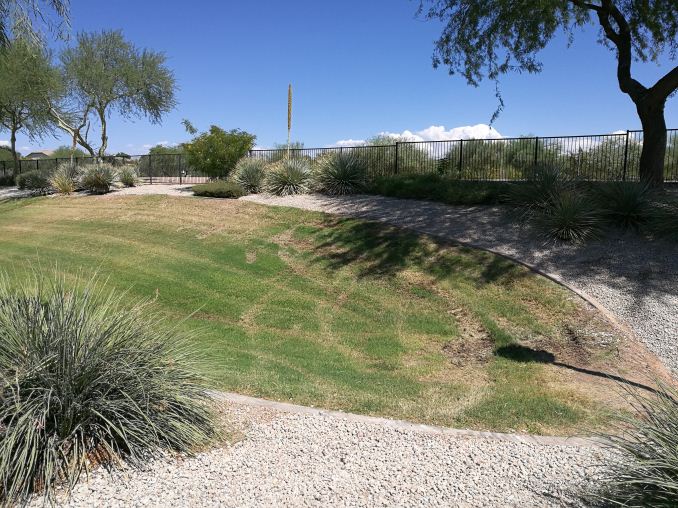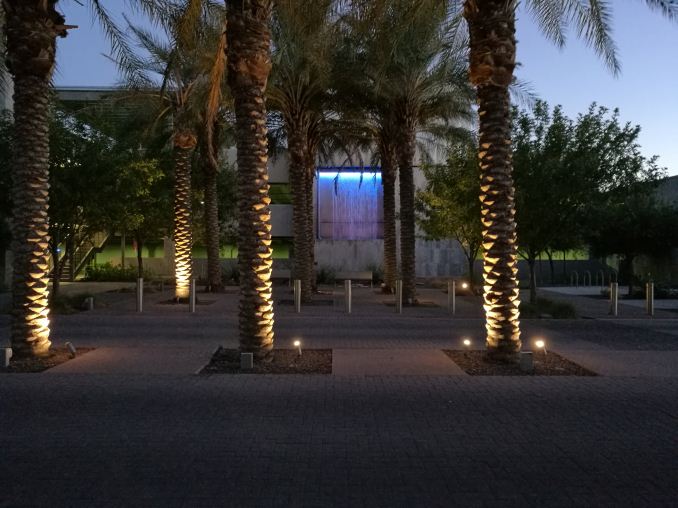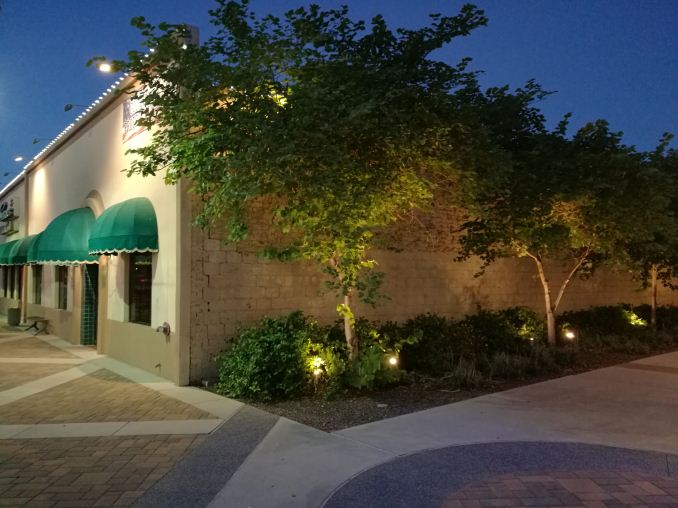The Huawei Honor 8 Review
by Matt Humrick on October 13, 2016 8:00 AM EST- Posted in
- Huawei
- Smartphones
- Mobile
- Kirin 950
- honor
Camera Still Image Quality
The Honor 8 is not the first phone with a dual camera nor will it be the last (it will not be long before it’s a standard feature), but it’s still fairly novel and interesting. To see what advantages (if any) it brings, I’ll be comparing its performance to several other cameras in a range of different settings. Unfortunately, the OnePlus 3 and HTC 10 are not available for testing, but the Samsung Galaxy S7 (12MP, f/1.7, OIS) will serve as a reference for high-end performance, while the Huawei Honor 5X (13MP, f/2.0) will serve as the lower bracket. The LG G5 (16MP, f/1.8, OIS) and Motorola Moto Z Play Droid (16MP, f/2.0) are also in the mix. The Huawei P9 uses the same sensor hardware as the Honor 8 but uses different software and Leica branded lenses, so it will be interesting to see if these add up to better photos. All of these phones capture images natively with a 4:3 aspect ratio except the 16:9 G5, and all of the images were taken using the stock camera app's Auto mode unless noted.
| Daylight Photo Comparison 1 |
In this first sunlit scene all of the cameras capture nice-looking photos, but there are some noticeable differences. The Honor 8 and Huawei P9 take a good exposure using the same ISO and shutter speed settings and avoid clipping the clouds like the Honor 5X and Moto Z Play. The Galaxy S7 is more conservative, slightly underexposing the scene.
The LG G5 captures the most accurate colors; it’s the only camera that does not oversaturate the blue sky. The Moto Z Play is a close second followed by the Honor 8 and P9, which give the sky a purplish tint. Both the Galaxy S7 and Honor 5X miss the proper white point: The Galaxy S7’s image has a slight green tint while the Honor 5X’s image is too cool.
Taking a closer look reveals that the Honor 5X’s image shows the most visible noise grain, although it’s still acceptable. The images from the G5 and S7 also show a bit more shot noise in the sky than the Honor 8, P9, and Moto Z Play. Comparing the Honor 8 and P9 shows a significant difference in noise reduction processing. The P9 does a little better job smoothing the sky, but it selectively applies more processing to darker areas in the image, smearing away detail from the bushes, grass, and rocks sitting in shadow while preserving detail in sunlit areas. The Honor 8 avoids this issue, and as a result I’d say the Honor 8 captures a better overall image than the P9 here.
| Daylight Photo Comparison 2 |
All of the phones except the Honor 8 and P9 overexpose this image and clip the highlights on the truck’s hood, with the Honor 5X going the furthest and clipping the sidewalk and sky too. It looks like the Honor 8 and P9 take a faster exposure to avoid clipping and then compensate by adjusting gamma higher to brighten the image. The result is a bright, nicely exposed image that’s lacking a bit of color saturation. Personally, I think the Honor 8 and P9 take the best images in this scene. Plus you can always increase color saturation with image editing software later, but you cannot recover the detail that’s lost in the clipped highlights from an incorrect exposure.
The Honor 8’s image also looks the best after zooming in. There’s very little noise with a high level of detail; the lettering on the building is clearly visible. The P9’s photo is similar but again we see it selectively apply more aggressive noise reduction on darker areas of the image, in this case wiping away detail from the road. Once again the Galaxy S7 and G5 show more noise grain than the Honor 8 and P9, but it’s a minor difference. The G5 somehow manages to show more noise than the S7 and still smear away more detail, particularly noticeable on the road. The Honor 5X’s photo has more visible noise grain everywhere and the Moto Z Play’s image shows some jpeg compressions artifacts around the lettering on the building.
The Honor 8, like the P9, does not offer an automatic HDR mode. Instead, it has to be enabled manually from a sub-menu, which is a bit inconvenient. The Honor 8 captures HDR images pretty quickly, roughly in 0.5 seconds, the same as regular photos, but this might just be the result of broken HDR processing. Looking at both sets of the Honor 8’s images above shows no difference between having HDR on or off, despite the camera app confirming the mode was turned on with a label on the screen. I tried taking many other HDR photos too, toggling the mode on and off, opening and closing the camera app, and even rebooting the phone, but I could not perceive any difference between photos with HDR on or off.
I encountered this problem with the P9 initially too, but at some point the issue resolved itself and HDR now works reliably. Even when it works, however, HDR has little effect on the P9’s images. It tends to brighten the entire image, rather than constrain itself to shadows, but only slightly. Huawei definitely needs to improve its HDR algorithm (and get it to work reliably) if it wants to compete with Samsung’s and LG’s cameras.
| Evening Photo Comparison 1 |
These photos were taken at sunset when there was still a little light left in the sky. While all of the cameras did well in sunlight, we start to see some obvious differences when there’s less light to work with. The Galaxy S7, LG G5, and Moto Z Play all expose for the foreground, creating brighter images but overexposing the sky. The G5 takes this to the extreme, automatically engaging its long exposure mode leading to an unnaturally bright image with a completely blown out sky. The Honor 8 and P9 opt for a more accurate exposure, creating darker but more realistic images. Determining which approach is better comes down to personal taste.
The Galaxy S7 and Honor 5X bracket the group in both price and performance, capturing the best and worst images, respectively. The Galaxy S7 sets the white point correctly and produces nicely saturated colors. It also keeps noise to a minimum and easily captures the most detail. The Honor 5X captures the darkest image but still overexposes the sky. It sets the white point too cool, has trouble focusing, and captures a noisy image.
The Honor 8, P9, and LG G5 all experience autofocus issues too. Even after taking several pictures with each, not a single one is properly focused. The Honor 8 sets the white point a little too cool, while the P9’s colors skew too yellow. The Moto Z Play’s image is not perfect, but color is good and both noise and detail are pretty good, giving it the edge over Huawei’s phones.
| Evening Photo Comparison 2 |
This group of pictures taken outside a restaurant after dark shows similar results. The Galaxy S7, LG G5, and Moto Z Play opt for longer exposures to brighten the scene, but overexpose the highlights on the building in the process. The Honor 8 and P9 avoid this issue, capturing more accurate, albeit darker images. The Honor 8 also experiences trouble focusing again; its best image is still a little blurry. The P9’s autofocus gets it right, capturing a sharp image with less visible noise grain and better detail than the Moto Z Play and Honor 5X. Neither the P9 nor Honor 8 can top the sharpness of the S7’s and G5’s images, however.
The Honor 8’s dual camera handles exposure very well across a range of conditions. Color saturation and accuracy is also pretty good, with only minor white point misses and a tendency to use darker shades of blue for the sky. In well-lit scenes, it keeps noise to a minimum and captures a lot of fine detail. Its autofocus system struggles in low light, but if you give it an assist by tapping to focus, it’s still capable of taking decent pictures. Although, it cannot match the performance of more expensive phones such as the Galaxy S7 and LG G5.
There is less difference between the Honor 8 and P9 than I expected. The images they produce are very similar, with nearly identical exposures and only very minor white point differences in low light. Noise reduction processing shows the biggest difference: The P9 selectively filters darker regions more aggressively, wiping away detail, which the Honor 8 avoids, tipping the image quality scale in its favor.
The only significant issue I found with the Honor 8’s rear camera is with HDR processing, or rather the lack thereof. I could not get HDR to work on my review unit. Even if it did work, the results would not be very impressive based on the P9’s HDR images. This is definitely a feature that needs improving.
Video Quality
The Honor 8 includes a number of nice video recording features that leverage the processing power of the Kirin 950 SoC and its dual-core ISP developed by Huawei. While the camera does not have OIS, there is an option for electronic image stabilization (EIS). The Honor 8 also includes optional object tracking autofocus similar to Samsung’s Galaxy phones. Tapping a moving object on the screen tells the camera to keep it in focus as it moves around. The feature works pretty well, but the camera can lose track of the object if it moves too fast or if there’s sudden changes in ambient light.
Another nice feature is the pro video mode that allows manual control over a few settings. It’s not as comprehensive as the pro photo mode, but it’s more than you get with most other phones. The pro mode allows you to adjust the metering mode, control focus manually, perform exposure compensation, and adjust the white balance, either by using one of several presets or adjusting it manually in 100K increments. The display shows a live preview of the changes, but adjustments cannot be made once it starts recording video.
| Huawei Honor 8: Rear Camera Video Modes | ||
| Video Mode | Video | Audio |
| FHD 1080p60 | 1920x1080, 34 Mb/s, H.264 C. Baseline | 192 Kb/s, 48 KHz AAC |
| FHD 1080p | 1920x1080, 17 Mb/s, H.264 C. Baseline | 192 Kb/s, 48 KHz AAC |
| HD 720p | 1280x720, 12 Mb/s, H.264 C. Baseline | 192 Kb/s, 48 KHz AAC |
| VGA 480p | 640x480, 5 Mb/s, H.264 C. Baseline | 97 Kb/s, 48 KHz AAC |
| QVGA 240p | 320x240, 1.2 Mb/s, H.264 C. Baseline | 97 Kb/s, 48 KHz AAC |
| MMS | 176x144, 195 Kb/s, H.264 C. Baseline | 97 Kb/s, 48 KHz AAC |
| Slo-mo | 1280x720, 120fps, 48 Mb/s, H.264 C. Baseline | 192 Kb/s, 48 KHz AAC |
| Huawei Honor 8: Front Camera Video Modes | ||
| Video Mode | Video | Audio |
| FHD 1080p | 1920x1080, 14 Mb/s, H.264 C. Baseline | 192 Kb/s, 48 KHz AAC |
| HD 720p | 1280x720, 12 Mb/s, H.264 C. Baseline | 192 Kb/s, 48 KHz AAC |
| VGA 480p | 640x480, 5 Mb/s, H.264 C. Baseline | 97 Kb/s, 48 KHz AAC |
| QVGA 240p | 320x240, 1.1 Mb/s, H.264 C. Baseline | 97 Kb/s, 48 KHz AAC |
| MMS | 176x144, 195 Kb/s, H.264 C. Baseline | 97 Kb/s, 48 KHz AAC |
It’s great to see a 1080p60 mode included, which is useful for filming action scenes because it greatly reduces the jerkiness that occurs with 30fps video. The downside is that the Honor 8 cannot use EIS or its object tracking autofocus when shooting 1080p60. Conspicuously absent is a 4K video recording mode, which has rapidly become a near standard feature on mid-range and flagship phones. When I asked Huawei why it does not include 4K recording with the Honor 8 and P9, it said that it does not see enough difference in quality to justify the increase in power consumption.
The Honor 8’s 720p120 slow-motion video is actually pretty good. The video looks darker and shows more noise than standard 720p video, but this is unavoidable due to the faster shutter speed required when shooting at 120fps versus 30fps. The video looks smooth and does not look like it’s being upsampled from a lower resolution. After shooting a video, it’s easy to adjust which segment of the video plays in slow motion, and exporting the video does not require any additional steps. As a bonus, the Honor 8 records audio with slow-motion video too, a rarity among Android phones. The audio sounds pretty good, but there’s a little too much reverb.
Overall video quality in its other modes is above average. Just like with still pictures, the Honor 8 consistently does well with exposure and white balance. Sometimes colors seem a bit undersaturated, possibly because it’s increasing gamma to brighten the video like it does with still photos, and the lack of HDR is certainly noticeable, although most phones still cannot do HDR video. When moving between light and dark areas, the Honor 8 does at least adjust the exposure quickly and smoothly to compensate as shown in the video sample above.
The Honor 8 uses the constrained baseline profile for all video modes instead of the high profile we prefer, and its bit rates are pretty typical for smartphones, resulting in some faint motion artifacts but nothing too severe. The Honor 8 is also slightly above average when it comes to video noise, ranging from very low with good detail in bright light to pretty grainy and soft in low light. Noise is also significantly more noticeable when recording 1080p60 video, including some yellow splotches mixed in with the random noise.
The Honor 8’s EIS works pretty well at eliminating small vibrations from shaky hands and also damping larger vibrations from walking. Obviously there’s a limit to what it can do, and it will create some jittery artifacts if there’s too much movement, but overall video looks better with it on then off. The autofocus system is also above average, continuously adjusting focus as needed, but occasionally getting hung up or adjusting more slowly when falling back to contrast AF. The Honor 8 is also pretty sensitive at picking up audio. I did not notice an issue with wind noise, but there was only a very slight breeze while I was recording.


























95 Comments
View All Comments
Matt Humrick - Friday, October 14, 2016 - link
That's a good point. The Smart mode selectively reduces screen brightness when using specific apps. It does not alter screen brightness for the PCMark test, which is one reason why there is not a bigger gap between it and the Performance mode; however, it does drop brightness from the calibrated 200 nits to about 100 nits when using the Chrome browser, which would increase the battery life in our web browsing battery life tests (these were run in Performance mode).prku - Friday, October 14, 2016 - link
Honor 8 is not a dual-standby dual sim phone. Please check again. it is supposed to have Dual Sim Full Active (which is a major selling point). DSFA is supposed to be present in all but Indian variations of the Honor.randomlm - Saturday, October 15, 2016 - link
Thanks for the nicely written, well balanced and non-biased review matt. This is the standard I've come to expect from anandtech that imo, some other reviewer on this site hasn't been delivering, especially on the camera portion of the review.Of course, entirely just my opinion
Feegenie - Saturday, October 15, 2016 - link
Fair.........jvl - Saturday, October 15, 2016 - link
"It’s a bit unfair to point our fingers solely at the OEMs and carriers, of course, because it was Google that created this mess and, ultimately, only Google can clean it up."What.
lagittaja - Saturday, October 29, 2016 - link
Do you even Android? Version distribution. Google can't force OEM's or carriers to update the devices.Even Android N's "auto update" doesn't really fix anything.
Why would the carrier or OEM keep updating the devices if they can just drag their feet on the ground making the update process as slow and painful as possible or just flat out not update them? Even once? The consumer will just buy a new device anyway.
Between 29th Aug and 5th Sept, of all the devices "phoning home" to Google a whopping 81.3% were running Android Lollipop 5.1 or older version.
If you take Lollipop out of the equation, 46.3% of the devices were running KitKat 4.4 or older.
If you take KitKat out of the equation, still almost 20% of the devices were running Jelly Bean 4.3 or older..
https://developer.android.com/about/dashboards/ind...
http://www.infoworld.com/article/3072591/android/g...
Google even tried to downplay the issue during May I/O event saying "it's not fragmented".
https://data.apteligent.com/download-report?report...
Yeah, that looks SO much better... 80%+ of devices being used are running Lollipop or older. A third of the devices being used are running KitKat or older..
And saying yeah, well only KitKat, Lollipop and Marshmallow matter because reasons and hey look at that 92% of devices being "used" are running Android OS's that "matter" and oh hey in contrast to iOS there's only iOS8 and iOS9 that matter and oh hey that comprises 97% of the iOS traffic. We're just as good as Apple! Yey us!
Uhm no.. Apple keeps it tidy because they have CONTROL...
iOS 9 only runs on devices that are from 2011 or older.
iOS 10 only runs on devices that are from 2012 or older.
Google has no control what so ever of Android devices that are not made by them.
Bloody hell, there's still Android devices sold new that run KitKat. And guess what, most of them are not going to receive a single damng update because the OEM doesn't give a flying fuck about it.
Look at Apple, look at what devices they sell. Guess what, they run iOS 10 or are just waiting to be turned on so they can nag you that there's a pending update.
With Android Nougat Google should have grabbed the "bull by the horns" and just fix the God damn problem.
They should have made a way for them to be able to at least deliver the critical security updates to the devices "automagically" no matter what sort of customizations OEM's or carriers have done.
I don't have the faintest idea of how that could be done but it's the least that needs to be done.
P.S. I'm an Android user and always will be. I don't like Apple's devices or their OS but I like how good control they have over their devices.
phuzi0n - Sunday, October 16, 2016 - link
Is this a phone review or a car review? We could do without all the car analogies in the first three paragraphs.Badelhas - Sunday, October 16, 2016 - link
I hate these Chinese UI skins which are iPhone iOS imitations. But that's just me.nkuehn - Friday, October 21, 2016 - link
Matt, did you also do testing on the Cellular Performance? Anandtech is famously good at really testing and not just testin, but I'm totally missing this part. I'm asking because some other reviewers had serious issues with the LTE performance of the device, losing LTE connection in well covered area etc.Maybe partner with people like http://cellularinsights.com/ - they have the testing hardware for cell that you have for displays and all the other stuff.
Savanah - Thursday, October 27, 2016 - link
I am so glad I went for the Moto Z Play instead of the Oneplus 3. It has a premium build quality, great display, awesome battery life, buttery smooth performance and decent cameras. It also excels in areas we tend to take for granted like call quality and signal retention. And to top it off it is bound to get fastest Android updates of any non Nexus/Pixel device. What else can you wish for in a $350 smart phone?